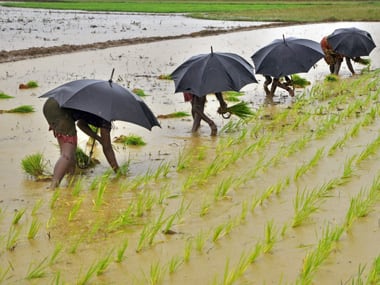Farmers with small land holdings must thank Reserve Bank of India (RBI) governor Raghuram Rajan for the recent changes made in the so-called priority sector lending norms announced in the last week of April. The central bank has acted smart and bold by stipulating specific lending target for banks towards small farmers, which would make sure that banks indeed reach out to them. Small farmers are a long ignored segment and often looked at by lenders only for the sake of regulatory compliance. Hence many of the poor farmers were forced to turn towards the private moneylenders, eventually losing their pledged land or valuables on account of abnormally high interest rates charged. Until now, the definition of the priority sector was vague. [caption id=“attachment_2230384” align=“alignleft” width=“380”]  Reuters[/caption] Banks were given a combined target of 18 percent (which include direct and indirect lending) and most times, small farmers were ignored since there wasn’t clarity on how much money should go to them. Banks often preferred to lend to large, established farmers than high-risk small farmer in the hinterland. Now, out of the total priority sector lending, the central bank has said that 8 percent of the loans should go to small and marginal farmers or farmers possessing less than two hectares of land. Besides, the RBI has said that 7.5 percent of money should go to micro enterprises — entities defined as investment in plant and machinery not exceeding Rs 25 lakh. This segment, again, has long been excluded from the banking system. Both these targets would ensure tiny borrowers gets assistance. “RBI’s definition of agriculture with respect to the priority sector lending was restricted in nature earlier and now that issue has been addressed,” said Jayanta Kumar Sinha, former chief general manager, rural business at State Bank of India. “With a sharper focus on small farmers, the priority lending would reach the needy segments,” Sinha said. Secondly, the RBI has also abolished the distinction between direct (earlier 13.5 percent of the total loans) and indirect (4.5 percent) and has combined the both. Direct lending refers only to primary activities in the process of cultivation. With the central bank doing away with the direct, indirect classification, banks are free to lend for purposes, where the farmer needs money and not over-fund the crop production. Other activities such as processing the crop, building warehouses — which was somewhat limited before — will now get funding. For a farmer, processing the crop is equally critical as cultivation. For long, overhauling the priority sector lending rules was discussed, with multiple committees, headed by experts such as former Union Bank of India chairman, M V Nair and RBI board member, Nachiket Mor had offering recommendations, but the action was absent. The central bank has now taken the much needed step. Bank lending to agriculture, for the past many years, has been more of a misdirected exercise with banks engaged in relaxed credit appraisal process and lending to anyone to meet the yearly target and not necessarily to the one who is actually in need of money. Logically, bad loans from the farm segment have shot up in the books of many state-run banks over years. Sadly, farm lending took the shape of a political issue — something that finance ministers proudly read out in the budget documents — and hardly do any follow up to see if the money reaches the targeted segments. Until March, banks have a total loan outstanding of Rs 7.7 lakh crore to agriculture and allied activities that grew at bout 15 percent on a year-on-year basis. In the union budget 2015, finance minister Arun Jaitely has given a target of Rs 8.5 lakh crore to banks, which, if achieved would constitute 14 percent of the total bank loans. Interestingly, even during the much-hyped farm debt waivers (remember the Rs 70,000 crore waiver sponsored by P Chidambaram in 2008), empirical evidence shows that small, landless farmers were left out and most of the beneficiaries were big, rich farmers. The definition of farmer was misinterpreted and the funding channels were misused. Under the new rules, large state-run banks wouldn’t have much difficulty in finding small and marginal farmers, if they want to, given their massive reach across the country. Butt small lenders, especially private banks, would find it difficult to meet the target. Even for foreign banks with minimal presence (less then 20 branches), the RBI has stipulated the 40 per cent priority lending target but has given a time of five years to achieve that. The message from Rajan is clear: Bankers just cannot afford to ignore the issues of poor.
Small farmers are a long ignored segment; the new norms will likely change this
Advertisement
End of Article


)

)
)
)
)
)
)
)
)



